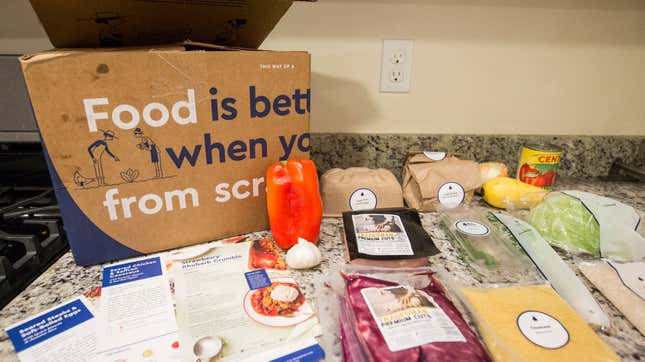
For the past few years, I’ve watched the rising popularity of meal kits from companies like Blue Apron and HelloFresh with deepening skepticism. Stuffed with refrigerator packs and individually wrapped ingredients, festooned with farm-to-table marketing and recycling symbols, these conveniently packaged dinners seemed to epitomize corporate greenwashing. That can’t possibly be good for the planet, I thought every time a friend told me about their latest culinary adventure via kit.
As it turns out, I was probably a bit quick to judge this trend.
A first-of-its-kind study on the environmental footprint of meal kits has found that they actually can be more climate-friendly than buying the same ingredients for the same meal at your local grocery store. There are some important caveats to bear in mind here, but it basically comes down to food waste: because the ingredients are pre-portioned and brought to consumers more directly, meal kits, on average, seem to result in less thrown-out food. And from a carbon emissions perspective, that’s more important than the egregious packaging.
Meal kits are taking off, with the roughly decade-old industry now worth some $1.5 billion in the U.S. alone, and growing at a rate of 25 percent a year. This surging popularity means meal kits have the potential to be “transformative” to the food industry, as the the University of Michigan-based study authors note in their paper. Yet, very little is known about their environmental footprint.
To fill that gap, the authors selected five two-person meals from Blue Apron—salmon, cheeseburger, chicken, pasta, and salad—and prepped them using both the kit and the same ingredients purchased at a grocery store. For each preparation, the researchers attempted to estimate the total carbon footprint of the meal, considering everything from agricultural production to packaging to transportation to how much waste was generated.
When all was said and done, the meal kits were the environmental winners. Average carbon emissions for a meal from Blue Apron were 6.1 kg, about 33 percent lower than the 8.1 kg CO2 for the grocery store version. In every individual case except the cheeseburger, the meal kit bested its grocery store counterpart. (In that case, PhD student and lead study author Brent Heard told Earther, some of the kit ingredients were significantly heavier than their grocery store counterparts, resulting in higher emissions.)
The biggest reason meal kits did better, per the authors’ analysis, was that they result in less food waste on average by pre-portioning ingredients. Cutting out the grocery store can also help in the waste department, because, it turns out, grocery stores toss a lot of food in the trash, too.
“One thing that really surprised me: I hadn’t quite realized the amount of environmental impact contributed through the supermarket retail process,” Heard told Earther. “That includes foods that become food loss from overstocking or stores culling blemished produce, but also operation of supermarkets.”
The study, published in the journal Resources, Conservation and Recycling, also found that meal kits resulted in lower so-called “last mile” emissions, the final transit leg needed to get the food from distribution center to kitchen. Because meal kits are delivered via trucks that make many deliveries, each individual box embodies a small portion of the last-mile transit emissions—a stark difference from driving yourself to the store to pick up ingredients for your dinner and nobody else’s.
Together, reduced waste, reduced last-mile emissions, and the refrigeration packs in meal kits (which turned out to be a more climate-friendly than the giant refrigeration systems in grocery stores), more than offset the 0.17 kg extra carbon dioxide associated with a meal kit’s packaging. And while the authors focused their paper on greenhouse gases, they conducted similar analyses of land and water use and nutrient pollution, and the results were, Heard said, “largely similar.”
Now, there are a lot of assumptions here—about your behavior and where you’re getting your food—that make the findings difficult to scale down to the individual level. According to Heard, the authors included a “sensitivity analysis” where key variables, like how many trips consumers take to the grocery store per week or how much food they toss, were varied between two extremes, “and we didn’t find a shift in the results overall in any real significant way.” Still, lead author Shelie Miller told Earther, the results “do tend to be on average.”
I asked if, as someone who walks to the grocery store, composts my food scraps, and is hard-wired to try and eat all of my leftovers, I’d be a candidate for switching to meal kits for the good of the planet. “Send us your data,” Miller joked, before adding that the study is not so much about dictating individual choice as it is about “mindful consumption.”
“A key highlight of the study is just how much household food waste there is and how impactful that can be,” she said.
Indeed, the USDA estimates that America tossed some 133 billion pounds of food—worth $161 billion—in the trash in 2010. Separate research has estimated that the average American wastes about a pound of food per day. Not only does it take energy and resources to grow that wasted food, but when it winds up in landfills it releases methane, a potent greenhouse gas. Whether you get all your food at farmers’ markets or order takeout every night, we all have some responsibility to bear here.
And if we consumers can be more mindful, so can the companies we’re purchasing from. Grocery stories can work to reduce their food losses and switch to more environmentally friendly forms of refrigeration.
Meal kit companies can give themselves a pat on the back for their portion control. But they still need to figure out how to reduce the damn packaging.